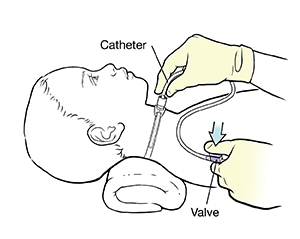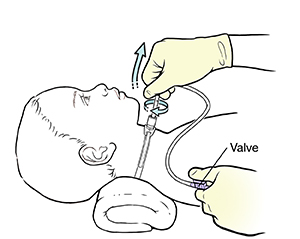When Your Child Needs a Tracheostomy: Suctioning
ucus can often build up and thicken in a tracheostomy (trach) tube. This can plug the trach tube, making it hard for your child to breathe. Regular suctioning of mucus keeps the tube clear. You will be instructed on how to suction mucus to keep the tube clear. You will also be instructed about methods for cleaning catheters and how deep to insert them while suctioning. It's also important to know how to do CPR for your child with a trach tube. Below are the basic steps for suctioning. Follow any other instructions you are given.
When to suction
Suctioning is often done just before changing and cleaning the trach tube. It should also be done before your child goes to sleep and when they wake up. But you may need to suction more often depending on your child’s age, the reason for the trach tube, and if they are sick. An older child may be able to tell you if they feel that suctioning is needed. Here are signs that you may need to suction:
-
Your child is breathing more quickly or seems very restless.
-
You hear a whistling or rattling sound when your child breathes.
-
There are bubbles of mucus at the trach opening or you hear gurgling or rattling sounds as if mucus is present.
-
Your child is having trouble breathing or eating.
-
Your child's color is paler or blue-ish (cyanotic).
-
Your child's nostrils are flaring.
Gathering your supplies
As with cleaning, you may find it easier to set up in the same area each time you do suctioning. Choose a clean, well-lit space near a sink. It's a good idea to have a resuscitation bag close by as well as a new trach tube in case of an emergency with the trach. Suctioning supplies include:
-
Clean, disposable, powder-less gloves
-
Suction machine, tubing, and catheters (you may also use another premarked catheter to help guide insertion depth)
-
Sterile water
-
Sterile saline solution
-
Syringe or eyedropper
-
Sterile or clean cup
Setting up your equipment
First explain to your child what you are about to do. Then set up what you will need:
-
Wash your hands with liquid soap and water. Scrub your hands for at least 20 seconds. Dry well. You may also use alcohol-based hand sanitizer, if you don't have soap and water. Rub the sanitizer for at least 20 seconds over all areas of your hands.
-
Put on gloves.
-
Attach the catheter to the suction machine. Don’t touch the end that will go into the trach tube.
-
Turn on the suction machine to 50 mmHg to 100 mmHg. Ask your provider about what suction pressure is best for your child. Suction pressure may vary depending on your child's age.
-
Pour sterile water into a cup.
-
Test to see if the catheter is working. Dip the tip of the catheter into the sterile water.
Suctioning the trach tube
Below are basic instructions for suctioning. You may have been given additional instructions for your child.
-
Do this step only if your healthcare provider tells you to: Use a syringe or eyedropper to put a small amount (about 1 mL) of sterile saline solution into the trach tube. This helps loosen mucus.
-
Have your child take a few deep breaths. This may cause your child to cough briefly. This is normal and helps to clear the mucus.
-
Put a catheter gently into the trach tube as far as you’ve been instructed to. (Insertion depth depends on the size of your child and the length of the trach tube.)
-
Apply suction by covering and uncovering the suction valve on the catheter.
-
While twirling the catheter, withdraw it to remove mucus. Don't keep the catheter in place for more than 3 to 4 seconds at a time.
-
Draw saline from the cup into the catheter to clear it of mucus.
-
Let your child rest and breathe for 1 to 2 minutes.
-
Then repeat suctioning until the trach tube is clear and makes no more rattling sounds.
-
Check the secretions. Tell the healthcare provider if there are any changes in odor, thickness, color, or amount.
-
Do other steps as instructed. For example, you may also suction your child’s nose and mouth. Or you may need to give extra oxygen (do this only if instructed).


Cleaning up
When you have finished suctioning:
-
Turn off the machine.
-
Throw away the saline and gloves.
-
Follow equipment supplier directions for how to clean the suctioning machine and how often.
-
Wash your hands again even when using gloves.
Making suctioning easier for your child
Suctioning can produce a gagging feeling, which can be scary to your child. Tell your child that this is normal. It may also help to do relaxing activities beforehand. Let your child rest in between suctioning. And don’t suction for any longer than your child can hold their breath. The whole session should last no more than 5 to 10 minutes.
When to call the healthcare provider
Call the healthcare provider right away if your child has any of the following:
-
Red or painful hole (stoma)
-
Small amount of bleeding from the stoma or tube that stops promptly
-
Yellow or green, smelly, bloody, or thick mucus from the stoma
-
Fever of 100.4°F (38°C) or higher , or as advised by the provider
-
Pain when you suction the trach tube
-
Very grouchy
-
Vomiting
-
Trach tube or suction catheter that is hard to insert
Call 911
Call 911 or get immediate medical care at the nearest emergency room if any of the following occur:
-
Shortness of breath or any trouble breathing
-
Swelling around the trach tube
-
Large amount of bleeding, or persistent bleeding, from the tracheostomy site